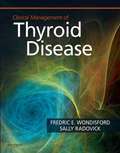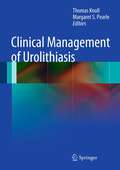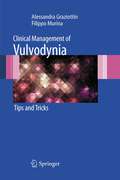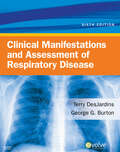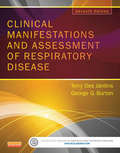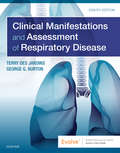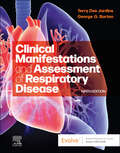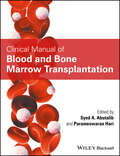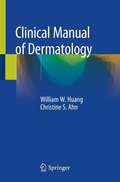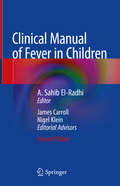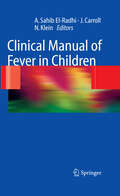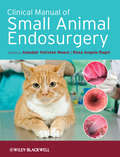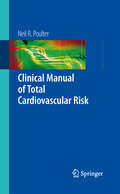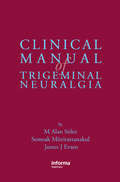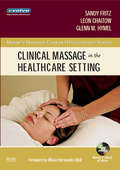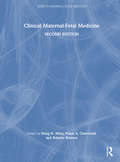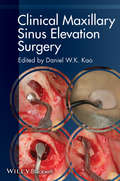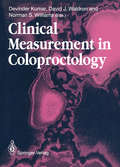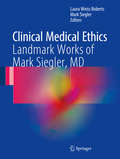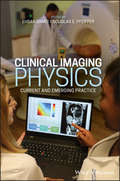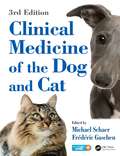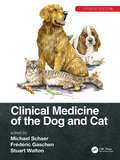- Table View
- List View
Clinical Management of Thyroid Disease E-Book
by Fredric E. Wondisford Sally RadovickClinical Management of Thyroid Disease is an exciting new book edited by Fredric Wondisford, MD—developer of the revolutionary new drug, Thyrotropin—and Sally Radovick, MD, with contributions from experts in the field. It fulfills the niche of a succinct, clinical resource to help you translate research into practice. This full-color volume offers valuable information on thyroid cancer and non-cancerous lesions, the effect of drugs on thyroid function, genetic disorders, and more in an accessible, easy-to-read consistent format.Presents the expertise of authors and editorial staff comprised of leaders in the field of thyroid research and clinical management for the best-qualified guidance on diagnosis and treatment. Provides a full-color, comprehensive approach that makes valuable information easy to locate and quick to read. Covers relevant topics applicable to all levels of training and expertise to serve as a detailed clinical reference on everything from the basic to the sophisticated. Captures research advances on hot topics such as thyroid cancer and non-cancerous lesions, the effect of drugs on thyroid function, and genetic disorders so that you can incorporate them into the way you treat patients.
Clinical Management of Urolithiasis
by Thomas Knoll and Margaret S. PearleA host of new technologies, techniques, and medical regimens have been introduced over the past 30 years for the diagnosis, management, and prevention of urinary calculi. These range from novel imaging procedures and medical expulsive therapy to interventional treatment options. The contemporary urologist should be familiar with and adept at implementing these new concepts and techniques. Clinical Management of Urolithiasis will serve as a practical guide to every clinically relevant aspect of urolithiasis and its treatment, both surgical and medical. In addition to providing up-to-date evidence-based recommendations regarding stone management, the book reflects the real-life experience of well-known international experts. Each chapter includes tables and algorithms that allow the reader easily to check the requirements for specific procedures and to translate them into clinical practice.
Clinical Management of Vulvodynia: Tips and Tricks
by Alessandra Graziottin Filippo MurinaChronic vulvar pain, or ‘vulvodynia’, is a common problem that can have a considerable impact on the wellbeing of patients. Despite being seen routinely in everyday clinical practice, it remains a neglected disorder that may take many years to diagnose.This book eases the way for physicians, including General Practitioners and Gynecologists, who are motivated to improve the lives of women suffering from vulvodynia. By offering a concise overview of the latest information on the diagnosis and management of vulvodynia, and its numerous comorbidities, in an easy to read, ‘tips and tricks’ format, the book empowers physicians to rapidly and effectively address the complex and sensitive issues surrounding the disorder.
Clinical Manifestations & Assessment of Respiratory Disease - E-Book
by Terry Des JardinsLearn to assess and treat respiratory care disorders! Now in full color, Clinical Manifestations and Assessment of Respiratory Disease, 6th Edition bridges normal physiology and pathophysiology to provide a solid foundation in recognizing and assessing conditions. Authors Terry Des Jardins and George G. Burton describe how to systematically gather clinical data, formulate an assessment, make an objective evaluation, identify the desired outcome, and design a safe and effective treatment plan, while documenting each step along the way. Unique coverage of Therapist-Driven Protocols (TDPs) prepares you to implement industry-approved standards of care. Unique! Clinical scenarios connect to specific diseases so you can better understand the disease and the treatment modalities used. Unique! A focus on assessment and Therapist-Driven Protocols (TDPs) emphasizes industry-approved standards of care, providing you with the knowledge and skills to implement these protocols into patient care. Case studies help in applying information to assessment and treatment. Overview boxes summarize the clinical manifestations caused by the pathophysiologic mechanisms of each disorder. End-of-chapter questions include multiple-choice, short answer, matching, and case studies to test knowledge and understanding, pointing out areas that might require further study. A glossary of key terms with definitions is included in the back of the book. Appendices offer easy access to information such as calculations, symbols, medications, and measurements, plus answers to selected case studies. A unique full-color design enhances content and shows realistic examples of diseases and conditions. Student-friendly features reinforce learning with chapter outlines, objectives, and key terms. A consistent presentation of disease information shows background, treatment, and assessment for each condition so you learn the material in a clear, cohesive manner. Over 15 additional case studies with answers are added to the companion Evolve website.
Clinical Manifestations & Assessment of Respiratory Disease - E-Book
by Terry Des Jardins George G. BurtonGet a deeper understanding of respiratory disease with Clinical Manifestations and Assessment of Respiratory Disease, 7th Edition. This popular, full-color text provides all the necessary tools you need to learn how to gather clinical data, formulate assessments, make objective evaluations, identify desired outcomes, design a safe and effective treatment plan, and document all the steps involved. Using easy-to-follow language and relevant clinical scenarios, this text gives readers a firm understanding of why certain treatment modalities are applied. And with a new chapter on respiratory failure and mechanical ventilation protocol, new information on electronic charting, and numerous updates in treatment and assessment added to nearly all the chapters, this new edition ensures you will be well-versed in all of the new issues affecting respiratory therapy.UNIQUE! Emphasis on clinical scenarios and critical thinking skills illustrates the causes of the clinical manifestations activated by specific respiratory disorders.UNIQUE! Focus on assessment and Therapist-Driven Protocols (TDPs) emphasizes industry-approved standards of care, providing readers with the knowledge and skills to implement these protocols into patient care.Case studies provide realistic examples of the respiratory therapist’s role in successful patient care and readers apply text information to clinical assessment and treatment. Self-assessment questions at the end of the text help readers personally assess their understanding of chapter material. Overview boxes summarize the clinical manifestations caused by the pathophysiologic mechanisms of each disorder.Student-friendly features reinforce learning with chapter outlines, objectives, key terms, and easy-to-follow language. NEW! New chapter on respiratory failure and mechanical ventilation protocol outlines the respiratory therapist’s role in regards to these protocols. NEW! New chapters on congenital diaphragmatic hernia and congenital heart diseaseNEW! Updated content on electronic charting offers the latest guidelines for collecting and recording respiratory assessments and treatment plans using an electronic health record.NEW! The most up-to-date content throughout ensures readers are well-versed in the latest assessment and treatment guidelines for various respiratory illnesses and injuries.NEW! Therapist-driven protocols (TDPs) information is now separated into two chapters to divide content between the basic treatment protocols and the protocols for mechanical ventilation and weaning from the ventilator.
Clinical Manifestations & Assessment of Respiratory Disease E-Book
by Terry Des Jardins George G. BurtonA realistic look at treating respiratory diseases! Clinical Manifestations and Assessment of Respiratory Disease, 8th Edition gives you a fundamental knowledge and understanding that is required to successfully assess and treat patients with respiratory diseases. Using a unique organization of material, this full-color text is divided into three distinct areas which show you how to first gather clinical data, then formulate assessments, make objective evaluations, identify desired outcomes, design a safe and effective treatment plan, and finally document all steps. With easy-to-follow language and relevant clinical scenarios, you will gain a firm understanding of why certain treatment modalities are applied. New to this edition is a chapter detailing Respiratory Insufficiency in the Patient with Neuro-Respiratory Disease, along with revised content which takes a deeper dive into latest developments, research, and practices and protocols in the treatment of respiratory disease.Revised content in the disease sections reflect the latest developments, research, and practices and protocols in the treatment of respiratory disease.UPDATED! Case studies on Evolve provide realistic examples of the respiratory therapist’s role in successful patient care and help you apply text information to clinical assessment and treatment. UNIQUE! Emphasis on clinical scenarios and critical thinking skills helps students understand the causes of the clinical manifestations activated by specific respiratory disorders.UNIQUE! Focus on assessment and Therapist-Driven Protocols (TDPs) emphasizes industry-approved standards of care, providing you with the knowledge and skills to implement these protocols into patient care.Overview boxes summarize the clinical manifestations caused by the pathophysiologic mechanisms of each disorder.Self-assessment questions at the end of the text help you to personally assess your understanding of chapter material. Student-friendly features reinforce learning with chapter outlines, objectives, key terms, and easy-to-follow language.NEW! Respiratory Insufficiency in the Patient with Neuro-Respiratory Disease chapter outlines the respiratory therapist’s role in regard to these protocols. NEW! Illustrations in designated chapters ensures you have a visual representation of disease processes, and the latest assessment and treatment procedures.
Clinical Manifestations & Assessment of Respiratory Disease - E-Book: Clinical Manifestations & Assessment of Respiratory Disease - E-Book
by Terry Des Jardins George G. BurtonA realistic look at treating respiratory diseases! Clinical Manifestations and Assessment of Respiratory Disease, 9th Edition gives you the fundamental knowledge and understanding required to successfully assess and treat patients with respiratory diseases. This foundation helps you learn how to systematically gather relevant clinical data; make an objective evaluation; identify the desired outcome and formulate an assessment; design a safe, appropriate, and effective treatment plan; and document all the steps involved. With this knowledge, you will understand the effectiveness of performing therapies and when to adjust therapy to a desired outcome. UNIQUE! Emphasis on clinical scenarios and critical thinking skills prepares you for real-world practice. UNIQUE! Focus on assessment and Therapist Driven Protocols (TDPs). UNIQUE! Overview boxes highlight the clinical manifestations for each disease. Logically organized content is written at a user-friendly, approachable reading level for ease of use and understanding. Case studies provide realistic examples of the respiratory therapy practitioner’s role in successful patient care. End-of-chapter self-assessment questions and answer key are available on the companion Evolve website. NEW! Clinical Connection boxes provide real-world clinical case studies in relevant chapters. NEW! An updated design and additional tables, boxes, and figures draw attention to key information. UPDATED! Content includes the latest developments related to SARS and COVID-19. UPDATED! Information on ventilators, usage, and protocols reflects current practice. NEW! QR codes in most chapters direct to additional outside content to enhance the chapter, including audio sounds and animations.
Clinical Manual of Blood and Bone Marrow Transplantation
by Syed A. Abutalib Parameswaran HariProviding the practicing and trainee hematologist with a practical and immediately applicable compendium of answers the Clinical Manual of Blood and Bone Marrow Transplantation covers the spectrum of the hematopoietic cell transplant specialty, in particular practical issues in transplant patient care, and the set up and functioning of a transplant program. Supplies the practicing and trainee hematologist with a practical and immediately applicable compendium of answers to clinical questions Covers the spectrum of the hematopoietic cell transplant specialty, in particular practical issues in transplant patient care, and the set up and functioning of a transplant program Contains concise chapters written with a focus on tables, algorithms and figures to aid rapid referral Benefits from expert contributions from an international authorship
Clinical Manual of Blood and Bone Marrow Transplantation
by Syed A. Abutalib Parameswaran HariProviding the practicing and trainee hematologist with a practical and immediately applicable compendium of answers the Clinical Manual of Blood and Bone Marrow Transplantation covers the spectrum of the hematopoietic cell transplant specialty, in particular practical issues in transplant patient care, and the set up and functioning of a transplant program. Supplies the practicing and trainee hematologist with a practical and immediately applicable compendium of answers to clinical questions Covers the spectrum of the hematopoietic cell transplant specialty, in particular practical issues in transplant patient care, and the set up and functioning of a transplant program Contains concise chapters written with a focus on tables, algorithms and figures to aid rapid referral Benefits from expert contributions from an international authorship
Clinical Manual of Dermatology
by William W. Huang Christine S. AhnThis manual provides an educationally focused and practically applicable resource for trainee dermatologists undertaking various dermatology board examinations. Concise, easy-to-follow chapters featuring relevant videos with editorial commentary aid the reader in developing an in depth understanding of a range of skin conditions and their management. Key concepts relevant to cutaneous neoplasms, fungal infections, dermatopharmacology, chemical peels, disorders of pigmentation and dermatopathology are all covered. Emphasis is placed on breaking topics down into modules, similar to that now taken by many dermatology board assessments for trainee dermatologists, aiding the reader easily access the content they need. Clinical Manual of Dermatology concisely describes many key concepts required to gain a thorough understanding of a range of topics in dermatology crucial to successfully completing dermatology board examinations. It is therefore, a valuable resource for all trainee dermatologists.
Clinical Manual of Fever in Children
by A. Sahib El-Radhi James Carroll Nigel KleinThis book discusses the latest scientific evidence related to fever and presents the principles of clinical practice, covering different types of fever and its possible complications. The book adopts a clearly defined, practical and effective approach to the management of fever, helping the clinician improve the care for the febrile child. The reader will learn about the guidelines on antipyretics and their side-effects and differential diagnoses, with problem-setting and solving as a case presentation.The second edition of this well-received book has been fully updated to include exciting new information of the pathogenesis of fever, including functions of interleukin and all the latest guidelines from NICE and Cochrane Library, as well as all the most up-to-date information and guidelines on febrile seizures.This reader-friendly reference on the disorders of body temperature in children covers the entire spectrum of subjects related to fever. It gives an overview of the best treatment options in order to achieve the best results. Containing a core message at the start of each chapter and with and a reader-friendly format this is an indispensable guide for paediatricians, family doctors and other professionals who are regularly consulted because of febrile children.
Clinical Manual of Fever in Children
by A. Sahib El-Radhi James Carroll Nigel KleinFamily doctors, pediatricians and other professionals who deal with children are regularly consulted because of febrile children. During the past few years remarkable advances on this subject of fever have been made. Among others, this book covers: - Different types of fever with possible complications, - Hyperthermia and their management, - Management of fever with guidelines on antipyretics and their side effects, - Complimentary medicine and fever, - Differential diagnosis of fever, with problem-setting and solving as a case presentation. This reader-friendly reference on the disorders of body temperature in children covers the entire spectrum of subjects related to fever. It gives an overview of the best treatment options in order to achieve the best results.
Clinical Manual of Small Animal Endosurgery
by Alasdair Hotston Moore Rosa Angela RagniA practical and comprehensive guide to rigid endoscopy and endosurgery in small animal practice. Fully illustrated throughout, it covers the clinical treatment of small animals from pre-operative through to post-operative care. With reference to specific procedures, this manual includes guidance on the selection of equipment, surgical techniques, anaesthesia and possible complications. A specialist chapter advising on the treatment of birds, reptiles and small mammals is also included. Clinical Manual of Small Animal Endosurgery will enable veterinarians to develop and improve their endoscopic techniques in clinical practice, as well as providing guidance on referral options for more complex cases. KEY FEATURES • Provides comprehensive information on how to perform rigid endoscopic investigations and procedures. • The focus is on dogs and cats with a specialist chapter covering the treatment of exotic small animals • Contains many full colour clinical photographs • Written and edited by experts in the field
Clinical Manual of Total Cardiovascular Risk
by Neil R. PoulterOver the last 10–20 years, there has been an increasing appreciation of the need to manage individual risk factors for cardiovascular disease (CVD) in the context of overall cv risk rather than on the basis of the absolute level of any given risk factor. This approach has given rise to the misnomer “global risk” and gen- ated extensive “lip-service” around this more broad-minded approach to managing risk factors and the prevention of CVD. This short book was devised with the idea of providing a practical summary of the rationale for management based on estimated total CV risk and the various methods associated with so-doing. Practical issues are addressed including treatment thresholds and targets for the major risk factors on which we routinely intervene, and a brief descr- tion of the major means of these interventions is provided. Whilst a multifactorial approach to CV prevention is logical and reflects the pathophysiological processes which underpin the formation of athe- sclerosis, the evidence base to guide practice using estimated CV risk (“global risk”) as a threshold for intervention is essentially non-existent. Meanwhile, pending supportive evidence from randomized trials, prac- cal, pragmatic, and cost-effective approaches to preventing CVD, which is the current biggest contributor to global mortality and burden of disease, is urgently required. The hope is that this book may make a small contribution toward reducing the horrendous burden which CVD currently imposes on the world.
Clinical Manual of Trigeminal Neuralgia
by M. Alan Stiles Somsak Mitrirattanakul James EvansResearch into pain has grown exponentially over the past few years, and our understanding of mechanism and pharmacology has also developed. Trigeminal neuralgia often goes unrecognized or is mistaken for other causes of facial pain, and while the cause often cannot be determined, it can be associated with multiple sclerosis, herpes zoster, and vari
Clinical Massage in the Healthcare Setting - E-Book: Clinical Massage In The Healthcare Setting (Mosby's Massage Career Development)
by Sandy Fritz Leon Chaitow Glenn HymelCovering advanced massage therapy skills, this practical resource prepares you to work with medical professionals in a clinical setting, such as a hospital, hospice, long-term care, or other health-related practice. It discusses the many skills you need to succeed in this environment, helping you become a contributing member of an integrated team. Also covered are the essentials of clinical massage, such as indications and contraindications, review of massage methods, range of motion testing, SOAP note documentation, and a massage therapy general protocol. Case studies show how a multidisciplinary approach applies to real-world clients. By coordinating your work with other health professionals, you can enhance patient care in any clinical setting!Includes a DVD with:Two hours of video showing specific applications, featuring author Sandy Fritz.A complete general protocol for massage.State-of-the-art animations depicting biologic functions and medical procedures.700 full-color illustrations accompany procedures, concepts, and techniques.An integrated healthcare approach covers the healthcare environment and the skills necessary to be a contributing member of an integrated healthcare team.A research-based focus emphasizes research, clinical reasoning, and outcome-based massage application — for effective massage application in conjunction with healthcare intervention.A complete general protocol provides a guide to treating disorders and maintaining wellness, with recommendations for positioning and interventions, using a step-by-step sequence that can easily be modified to meet a patient's specific needs.A palliative protocol helps you temporarily relieve a patient's symptoms of disorders or diseases.Case studies focus on outcome-based massage for individuals with multiple health issues, detailing assessment, medical intervention, justification for massage, and session documentation.Coverage of advanced massage therapy skills and decision-making skills includes specific themes for effective massage application, allowing you to consolidate massage treatment based on the main outcomes — useful when working with individuals with multiple pathologies or treatment needs.A discussion of aromatherapy provides safe recommendations for the use of essential oils in conjunction with massage, to promote healing of the body and mind.Descriptions of illness and injury include relevant anatomy/physiology/pathophysiology, as well as strategies and massage applications to use for pain management, immune support, stress management, chronic illness, and post-surgical needs.Coverage of insurance and reimbursement issues relates to you as a massage professional.Strategies for general conditions such as substance abuse, mental health, orthopedic injury, and cardiovascular disorders help you specialize in clinical massage.Expert authors provide knowledge in research, massage therapy in healthcare, and manual therapies.Learning resources include chapter outlines, chapter learning objectives, key terms, and workbook-style exercises.A companion Evolve website includes:PubMed links to research supporting best practices and justification for massage application.More information on topics such as insurance, pharmacology, and nutrition.More information on anatomy and physiology and other subjects.A comprehensive glossary with key terms and some audio pronunciations.
Clinical Maternal-Fetal Medicine (Series In Maternal Fetal Medicine)
by Hung N. Winn Frank A. Chervenak Roberto RomeroThis is a comprehensive, one-stop online book relating to all areas of pregnancy and birth. The second edition of this easily searchable guide is edited by eminent experts in the field and includes new contributions from international authors. It will be an ideal reference for Maternal-Fetal Specialists and Generalists wanting an authoritative answer on any point. Key features: •Grouped in to six topics (modules) for convenience•Electronic search facility across all chapters•Approximately 700,000 words of text, 7000 references, 300 figures (including 100 in full colour), and 200 tables available to search Key topics: •All common pregnancy and birth related problems such as diabetes and pregnancy•Many rarer complications such as protozoan infections•Fetal assessment, which is absolutely central to MFM practice•Medico-legal aspects•Sickle cell disease – a major problem for patients of African descent New chapters include: •Recurrent early pregnancy losses•Invasive hemodynamic monitoring•Chronic and acute hypertension•Neurological disorders•Maternal obesity•Assessment of fetal genetic disorders•First and second trimester screening
Clinical Maxillary Sinus Elevation Surgery
by Daniel W.K. KaoMaxillary sinus elevation, followed by placement of a wide variety of grafting materials, has been the generally accepted surgical protocol for the development of bone in the sinus cavity. Over the years, various techniques have been proposed for maxillary sinus elevation, which differ in surgical approach, bone graft materials, and advanced technology application for hard tissue and soft tissue management.Dr. Kao and a team of experts begin by discussing anatomy, radiographic image applications and limitations, and then provide step-by-step clinical procedures for the lateral window technique, including piezosurgery, and the trans-alveolar methods, including balloon and controlled hydostatic sinus elevation. Also included are chapters on post-operative care and complication management.
Clinical Maxillary Sinus Elevation Surgery
by Daniel W. K. KaoMaxillary sinus elevation, followed by placement of a wide variety of grafting materials, has been the generally accepted surgical protocol for the development of bone in the sinus cavity. Over the years, various techniques have been proposed for maxillary sinus elevation, which differ in surgical approach, bone graft materials, and advanced technology application for hard tissue and soft tissue management.Dr. Kao and a team of experts begin by discussing anatomy, radiographic image applications and limitations, and then provide step-by-step clinical procedures for the lateral window technique, including piezosurgery, and the trans-alveolar methods, including balloon and controlled hydostatic sinus elevation. Also included are chapters on post-operative care and complication management.
Clinical Measurement in Coloproctology
by Norman S. Williams David J. Waldron DevinderKumarCrucial decisions concerning surgical treatment are often based on the results of various methods used for assessing colorectal function. Yet the new methods which have resulted from recent technological advances are still often regarded as research tools or viewed with skepticism by the practicing physician. New horizons are opened up for the coloproctologist in this book which fully documents the scope of established and recently developed investigative techniques. These include manometry, electromyography, scintigraphy and defaecography. The discussion shows how each technique is conducted and in what way the results can be interpreted and used for the management of patients with colorectal disorders. Specialist areas such as the neorectum and the assessment of the pediatric patient are also included. This book clearly establishes the place of each technique in clinical practice. The text is clear and simple so that not only specialists but also non-specialists will be able to understand and set up the appropriate tests for specific colorectal disorders.
Clinical Medical Ethics: Landmark Works of Mark Siegler, MD
by Laura Weiss Roberts Mark SieglerThis instant gold standard title is a major contribution to the field of clinical medical ethics and will be used widely for reference and teaching purposes for years to come. Throughout his career, Mark Siegler, MD, has written on topics ranging from the teaching of clinical medical ethics to end-of-life decision-making and the ethics of advances in technology. With more than 200 journal publications and 60 book chapters published in this area over the course of his illustrious career, Dr. Siegler has become the pre-eminent scholar and teacher in the field. Indeed his work has had a profound impact on a range of therapeutic areas, especially internal medicine, pediatrics, surgery, oncology, and medical education.Having grown steadily in importance the last 30 years, clinical ethics examines the practical, everyday ethical issues that arise in encounters among patients, doctors, nurses, allied health workers, and health care institutions. The goal of clinical ethics is to improve patient care and patient outcomes, and almost every large hospital now has an ethics committee or ethics consultation service to help resolve clinical ethical problems; and almost every medical organization now has an ethics committee and code of ethics. Most significantly, clinical ethics discussions have become a part of the routine clinical discourse that occurs in outpatient and inpatient clinical settings across the country. This seminal collection of 46 landmark works by Dr. Siegler on the topic is organized around five themes of foundational scholarship: restoring and transforming the ethical basis of modern clinical medicine, the doctor-patient relationship, education and professionalism, end-of-life care, and clinical innovation. With introductory perspectives by a group of renowned scholars in medicine, Clinical Medical Ethics: Landmark Works of Mark Siegler, MD explains the field authoritatively and comprehensively and will be of invaluable assistance to all clinicians and scholars concerned with clinical ethics.
Clinical Medical Imaging Physics: Current and Emerging Practice
by Ehsan Samei Douglas E. PfeifferClinical Imaging Physics: Current and Emerging Practice is the first text of its kind—a comprehensive reference work covering all imaging modalities in use in clinical medicine today. Destined to become a classic in the field, this book provides state-of-practice descriptions for each imaging modality, followed by special sections on new and emerging applications, technologies, and practices. Authored by luminaries in the field of medical physics, this resource is a sophisticated, one-volume handbook to a fast-advancing field that is becoming ever more central to contemporary clinical medicine. Summarizes the current state of clinical imaging physics in one-volume, with a focus on emerging technologies and applications Provides comprehensive coverage of all key clinical imaging modalities, taking into account the new realities in healthcare practice Features a strong focus on clinical application of principles and technology, now and in the future Contains authoritative text compiled by world-renowned editors and contributors responsible for guiding the development of the field Practicing radiologists and medical physicists will appreciate Clinical Imaging Physics as a peerless everyday reference work. Additionally, graduate students and residents in medical physics and radiology will find this book essential as they study for their board exams.
Clinical Medical Imaging Physics: Current and Emerging Practice
by Ehsan Samei Douglas E. PfeifferClinical Imaging Physics: Current and Emerging Practice is the first text of its kind—a comprehensive reference work covering all imaging modalities in use in clinical medicine today. Destined to become a classic in the field, this book provides state-of-practice descriptions for each imaging modality, followed by special sections on new and emerging applications, technologies, and practices. Authored by luminaries in the field of medical physics, this resource is a sophisticated, one-volume handbook to a fast-advancing field that is becoming ever more central to contemporary clinical medicine. Summarizes the current state of clinical imaging physics in one-volume, with a focus on emerging technologies and applications Provides comprehensive coverage of all key clinical imaging modalities, taking into account the new realities in healthcare practice Features a strong focus on clinical application of principles and technology, now and in the future Contains authoritative text compiled by world-renowned editors and contributors responsible for guiding the development of the field Practicing radiologists and medical physicists will appreciate Clinical Imaging Physics as a peerless everyday reference work. Additionally, graduate students and residents in medical physics and radiology will find this book essential as they study for their board exams.
Clinical Medicine of the Dog and Cat (Manson Ser.)
by Michael Schaer Frédéric GaschenNo other comprehensive small animal veterinary medicine book exists with a comparable amount of relevant illustrated material. This new third edition continues and expands on the revolutionary approach of the previous two editions, now including more than 1,850 highly valuable clinical colour photographs, diagrams, and tables. The book is now divided into five color-coded sections – General Approach, Disease of Specific Organ Systems, Multisystemic Disorders, Elements of Therapy and Case Studies. As with the first and second editions of this book the overriding principle of succinct, yet comprehensive text presented in a clear format with an abundance of good quality images remains. Section I: General Approach is completely new and covers medical history and client communication, and common clinical problems. Section II: Specific Organ Systems is organized by body system with chapters structured in a systematic manner that include the definition for each disorder, its causes, clinical features, differential diagnoses, diagnostic methodology, treatment and prognosis, providing readers with easy access to important clinical information. New to this section are chapters covering diseases of the oral cavity and teeth, approach to thoracic radiographs, approach to abdominal radiographs, and disorders of hemostasis. Section III: Multisystemic Disorders covers revised and updated chapters including clinical toxicology, infectious diseases, and immunologic disorders. Section IV: Elements of Therapy covers therapies such as fluid therapy, pain management, nutrition of the critically ill dog and cat and a new chapter on management of the obese dog or cat. Section V: Case Studies includes over 25 case studies that enable the reader to relate the knowledge gained in the book to clinical cases seen in practice. Written by board-certified experts with several case contributions by clinicians in advanced phases of resident training, topics were carefully selected to make this a valuable resource to the general practitioner and also to small animal interns and veterinary students.
Clinical Medicine of the Dog and Cat
by Michael Schaer Frederic Gaschen Stuart WaltonThe fourth edition of Clinical Medicine of the Dog and Cat remains the most extensively illustrated and practical small animal veterinary textbook on the market. It continues and expands on the revolutionary problem-based approach of the previous three editions, with more than 1,100 clinical color photographs, diagrams, and tables. The book is divided into five color-coded sections—General Approach, Diagnostic Techniques, Disease of Specific Organ Systems, Multisystemic Disorders, and Elements of Therapy. For this edition: Case studies are integrated within the relevant chapters for ease of reference. The first section on common medical problems now includes abdominal distension, peripheral edema, proteinuria, regurgitation, and seizures. Chapters on thoracic and abdominal radiographs are now included in a unique new section on Diagnostic Techniques, encouraging an integrated learning approach. The third section contains detailed medical information covering most organ systems, with several chapters completely rewritten and others comprehensively updated to include additional text and images. Additional endoscopic, radiographic, CT, and MRI images are included alongside clinical photographs; very few veterinary textbooks have such a rich emphasis on photographs. Each section has a limited number of recommended updated references. The practical information is presented with text, tables, and algorithms, while each chapter is arranged to provide the definition of each disorder, its clinical features, the differential diagnoses, the diagnostic methodology, and the treatment and prognosis. The formatting has been improved to make this textbook easy to read and comprehend. The busy veterinarian or student is thus provided with a readily available resource of important clinical information in a clear, brief manner. Written by board-certified experts, the topics are carefully selected to make this a valuable resource for veterinary students as well as for general practitioners and small animal interns.
